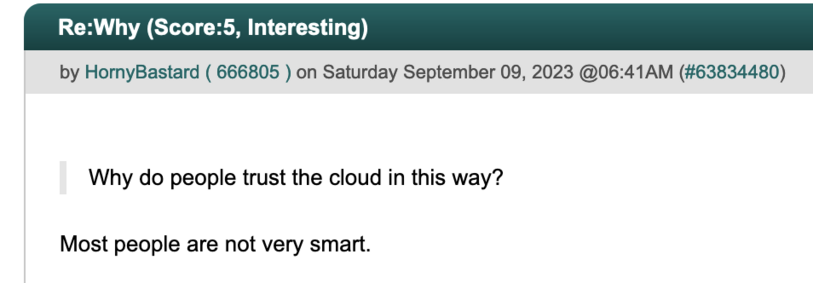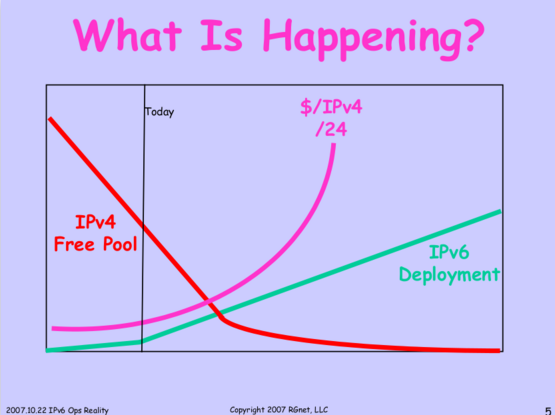· @FoxVK
30 followers · 398 posts · Server mastodon.cloudI trying to add #mldv2 ( #ipv6 #multicast ) support into #lwip
According RFC It looks that subscribers should always send report to query from router but I tried this with both Win and Linux an no OS is doing it.
Did I get it wrong?
current lwip with mldv1 seems to be ignoring any queries as well.
More details here: https://networkengineering.stackexchange.com/questions/84037/should-ipv6-multicast-subscribers-send-report-to-query
Doppellhelix · @Doppellhelix
55 followers · 986 posts · Server social.tchncs.deBrauche eure Hilfe.
Ich betreibe einen kleinen Heimserver.
-#Portweiterleitung in #FritzBox eingerichtet✅
-#DynDnS bei #noip (xxx.dds.net) eingerichtet und erfolgr. mit der FB verbunden✅
-> Komme ohne Probleme auf den Server.
Nun habe ich #ipv6 aktiviert.
-Portweiterleitung in der FB auf ipv4 + Ipv6 erweitert
-bei noip auf AAAA umgestellt,
-Dyndns erfolgr mit der FB verbunden.
Zugriff aus dem Internet ✅
Zugriff aus dem eigenen (W)LAN ❌
Was mache ich falsch?
#Portweiterleitung #fritzbox #dyndns #noip #ipv6
Dan Oachs · @doachs
150 followers · 589 posts · Server ipv6.socialA couple of good comments on Slashdot related to the article about Wyse cameras showing someone another person's camera.
Dan Oachs · @doachs
150 followers · 589 posts · Server ipv6.social@chrisgerhard There are lots of reasons, but one is that we have been dual stacked for 12+ years. I am ready to start dropping ipv4, but unfortunately the world is not ready. There are still a few things that don't work via nat64 etc. so other people not implementing ipv6 is holding back what is possible for me and others to do.
We need the demand for #ipv6 to be so great, supporting it can't be ignored. We are getting there, but very slowly and I'm tired of waiting.
Jody Lemoine 🇨🇦 · @ghostinthenet
366 followers · 888 posts · Server hachyderm.iofirewyre · @firewyre
108 followers · 1713 posts · Server techhub.socialFound out today our ISP was assigning us an #IPv6 address that the rest of the Internet thinks is in the #shithole state of Virginia (of all fucking places)!!! Well guess what, if you can't even properly assign me an IP that's in my home state, and not some ass-backwards, internet-regressive place like Virginia, then you can count me out of your little IPv6 transition... #disabled #IPv4FTW
#ipv6 #shithole #disabled #ipv4ftw
appzer0 - Libertadmin · @appzer0
76 followers · 471 posts · Server piaille.frAnderson Silva · @UnderEu
22 followers · 204 posts · Server mas.to@njalla Could you help the guys at nitter.net fixing #IPv6 connectivity on their side?
https://github.com/zedeus/nitter/issues/100#issuecomment-1712570701
- ft. @noipv6
Anderson Silva · @UnderEu
22 followers · 201 posts · Server mas.toPorque faz muito mais sentido botar a culpa no carteiro que entregou o pacote na tua casa do que na pessoa/empresa que não enviou o que você pediu ou se enviou, mandou pela metade ¯\_(ツ)_/¯
Klye · @khird
161 followers · 1035 posts · Server qoto.orgFor anyone using the DHCPv6 client app (be.mygod.dhcpv6client) on a recent version of Android, here's something that might save you some frustration - I learned it the hard way.
In theory, you'd only need the app to run occasionally if your leasetimes are reasonably long, so it's tempting to try and save battery by not exempting it from background restrictions. I figured I'd be clever and rig up a trigger to fire it every day plus whenever I reconnected to the network, which is probably cheaper than running a separate app constantly. And lo and behold, my wifi just couldn't hold a connection anymore.
After a lot of troubleshooting, it turns out that, when the app is killed off by the system, the underlying library removes any addresses it's acquired. On its face, this doesn't seem so bad, as the network should revert to IPv4-only after those addresses are removed. But it gets worse: because you stop receiving IPv6 traffic immediately, but the connectivity check takes a while to invalidate the cached IPv6 address it's monitoring, Android will interpret the fact that it's no longer receiving responses as evidence that the network failed. So your phone disconnects from the wifi - and if the whole cycle triggers on every connection, you'll never get more than about a minute of connectivity before it all comes crashing down.
So as far as I can tell, there's no alternative but to exempt it from background restrictions, and leave it running constantly even though you only need it to exchange a couple packets with the router every 24 hours. If anyone figures out a way to overcome this, I'd love to hear about it. Otherwise, I hope this helps someone else facing similar frustrations.
Hacker News 50 · @hn50
3527 followers · 72686 posts · Server social.lansky.nameFreeBSD pf bypass when using IPv6
Link: https://www.enricobassetti.it/2023/09/cve-2023-4809-freebsd-pf-bypass-when-using-ipv6/
Discussion: https://news.ycombinator.com/item?id=37437530
mkj · @mkj
144 followers · 1273 posts · Server social.linux.pizzaGetting closer and closer to working and usable #IPv6. I'm now getting a globally routable /56 assignment from my ISP (I'd prefer a /48, but a /56 slice out of 2000::/3 is absolutely usable) *and* I have confirmed that the egress firewall itself can talk IPv6 externally. Next step I suppose is to get the client to get an IPv6 address assignment out of that /56 and some routing table entries. 🙂 One step at a time...
Daltux · @daltux
32 followers · 130 posts · Server ayom.mediaFor those who like to rely on recursive global #DNS such as 8.8.8.8 or 1.1.1.1, I would recommend simply switching to 9.9.9.9, which is run by a #Swiss-based non-profit foundation and that also avoids malicious domains. The latency is practically the same. It is even better with #IPv6: 2620:fe::fe
It supports secure protocols DNS-over-HTTPS or TLS as well, very important to prevent the network from seeing everything you resolve, among other options.
#dns #swiss #ipv6 #bigtech #privacy
Daltux · @daltux
32 followers · 122 posts · Server ayom.mediaPara quem gosta de usar #DNS global recursivo como por exemplo 8.8.8.8 ou 1.1.1.1, #recomendo simplesmente alterar para 9.9.9.9, operado por fundação suíça sem fins lucrativos, e já impede domínios maliciosos. A latência aqui dá praticamente na mesma. Com #IPv6, é melhor ainda: 2620:fe::fe
Também suporta protocolos seguros DNS-over-HTTPS ou TLS, muito importantes para evitar que a rede veja tudo que está resolvendo, e outras opções.
#dns #recomendo #ipv6 #bigtech #privacidade #quad9
Manuel · @gehwissenlos
42 followers · 168 posts · Server sueden.socialShane Kerr · @shane_kerr
103 followers · 615 posts · Server fosstodon.orgA tale in 3 screenshots, without comment.
http://rip.psg.com/~randy/071022.v6-op-reality.pdf
https://www.google.com/intl/en/ipv6/statistics.html
https://circleid.com/posts/20230817-ipv4-prices-supply-and-demand-in-2023
Bertje · @Bertjes
19 followers · 190 posts · Server mastodon.nl@meesj Ik zag deze presentatie en dacht dat je dit misschien interessant zou vinden.
Thomas Schäfer · @tschaefer
512 followers · 2183 posts · Server ipv6.social
Marek Küthe · @mark22k
127 followers · 921 posts · Server layer8.spaceI'm trying DHCP and DHCPv6 on an Arduino Uno and I'm wondering why it doesn't work ... the script would use 264.3% RAM (5412 bytes / 2048 bytes).
#arduino #dhcp #dhcpv6 #ipv6 #outofmemory
Johannes Kastl · @johanneskastl
145 followers · 7718 posts · Server digitalcourage.socialLiebes Fediverse, vielleicht weiß hier ja zufällig, ob das überhaupt klappt und wenn ja, wie.
#vodafone Internet per Kabel (ehemals #kabeldeutschland), #kabelmodem im #bridgemodus, dahinter ein #router mit #openwrt
#ipv4 klappt wunderbar. Aber ich kriege kein #ipv6 egal was ich mache. DHCPv6 tut halt nicht.
Hat jemand einen ähnlichen Aufbau im Einsatz? Wenn ja, wie ist euer Router für IPv6 konfiguriert?
Und nein, ich meinen keinen IPv6-Tunnel 🙂
#ipv6 #ipv4 #openwrt #router #bridgemodus #kabelmodem #kabeldeutschland #vodafone



